The beliefs of the Tridean Goddess Tradition are based on evidence of what is believed to be the oldest form of human religion. Physical artifacts, such as hand-carved statues and cave art, place the source of these beliefs in Paleolithic Europe as early as 25,000 years ago or more. Hundreds of ritualized female figures exist from this time period that point to a system of belief which illustrates how life comes into being and how the Universe operates. There are no similar male figures found.
Looking at these figures, and their ritualized representations of the female form, it can be inferred that humanity’s first image of the life-giver was that of a mother. It is further concluded that these beliefs must go back to a time when people saw themselves as children of Nature, related to all of Creation, and part of a greater whole imagined as Goddess.
Trideans believe that Nature, and all things of Nature, are the Goddess in a multitude of physical manifestations. Nature is the sacred text of the human race and the blueprint that teaches us how to relate to the Goddess and to each other. It is the guide by which the spirit finds Completion; the sacred union of Oneness with all things.
While the Completion of the Goddess is the goal it is not believed to be attained through an idea of perfection, but through peace which can only come through understanding.
Lunar mythology predates solar mythology in most if not all cultures. For this reason Trideans believe that the moon is the source for all later cosmologies and thus continues interpretations of the Moon Goddess into the other natural cycles of sun and earth.
Through the waxing, full, and waning phases of the moon a Triple Goddess figure comes into being. A fourth aspect is evident with the dark phase of the moon, symbolizing the promise of rebirth into the Otherworld and the union of Completion. Each of these phases represents an aspect of the Goddess and illustrates a spiritual concept.
The cycles of the sun and earth, or the seasons, are seen to carry the same concepts of the
cycle of the moon on a grander scale. The solar year is a further, more detailed instruction from the blueprint of Nature where the Goddess is seen to be born from the Underworld, takes a mate, ages, dies, and gives birth again to herself in the act of rebirth.
The solar mysteries illustrate our connection to the rest of Creation through observations of the sowing and reaping of seeds, the lives of animals, and the changing of the Earth. The moon, by contrast, is a source of individual mystery representing ideas of intrinsically spiritual and personal awareness. Both of these cyclical systems are physical reflections of the adage “as above, so below”.
Some of the earliest images of the Goddess are depicted some what androgynously with both male and female principles. It is believed that the reason behind this is the idea of Oneness. The Goddess is completely female and completely male; having all the traits necessary for creation. She is the nothing less than the totality of being complete and without separation. The male aspect of the Goddess is seen as a horned animal, or as a half human, half animal being.
The Goddess is the whole while the God image is but a facet of her. The myth of the God/Hunter can not survive outside of the myth of the Goddess. Furthermore, myths of the God/Hunter/Son/Lover do not exist before the Bronze Age. The belief of a primordial Goddess of Oneness predates this time period by millennia.
Misconceptions of these myths have led some to believe that the male of the species has no part in the religion of the Goddess. This could not be further from the truth. In fact, since the Goddess is the representation of Oneness, she is ever present in all forms of life both male and female. While some mysteries of the Goddess are apparent through the female body and the act of giving birth, the image of the Goddess transcends any one woman or the female body. Men are as much manifestations of the Goddess as women are.
The Goddess creates parthenogenically, or of herself. While there is no separation and the Goddess does not exalt her female children over her male (or her two legged over her four legged) the female sex is considered the original form. All fetuses begin as female in their mother’s womb. Furthermore, recent evolutionary science has proposed that male reproductive organs are a secondary evolution that came about to keep the gene pool more diverse.
The Tridean myth cycle of the solar year depicts the Goddess rebirthing herself at the end of the year in the Otherworld. She then surfaces between the Winter Solstice and the Vernal Equinox. At the time of the Vernal Equinox she takes a mate – another manifestation of herself and her creation as Son/Lover. After finding her mate she becomes pregnant with the Child of Completion – herself.
Through Beltane and Midsummer the Goddess continues to grow with child. At Mabon her mate dies, leaving her an aging woman alone with herself and her memories. She now knows death and, as she mourns, works to understand its mysteries. She begins the transformation of becoming the Gatekeeper between the worlds and the one who guides the souls of the dead back to the Otherworld of her womb.
At Samhain the Goddess begins her own journey to the Otherworld, thinning the veil as she goes. It is within the Otherworld that her other aspects will join her to bring the Child of Completion to birth and begin the cycle again.
Labels: Goddess, Tridean Tradition, Writings
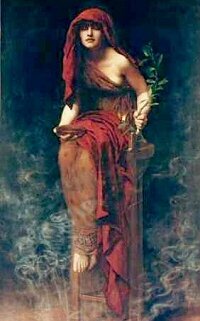 (A completely free form work in progress. Comments welcome.)
(A completely free form work in progress. Comments welcome.)
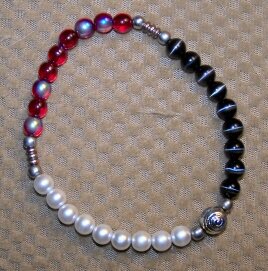

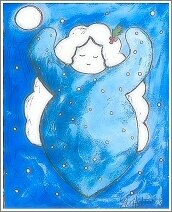
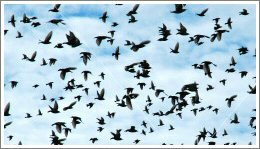 I saw a flock of birds today. Not just ten birds or twenty, but at least a hundred. They were pecking about in the grass on the side of the road near the onramp to the 390 expressway. I was sitting still, waiting in a line of cars with my blinker on. As the cars moved a little, inched their way forward one by one, the birds took flight.
I saw a flock of birds today. Not just ten birds or twenty, but at least a hundred. They were pecking about in the grass on the side of the road near the onramp to the 390 expressway. I was sitting still, waiting in a line of cars with my blinker on. As the cars moved a little, inched their way forward one by one, the birds took flight.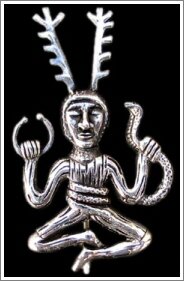 I am the Great Stag,
I am the Great Stag,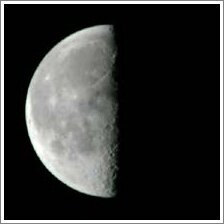 It's been raining for the past three days and I haven't felt gloomy just yet. It feels like a cleansing of the summer heat and an ushering in of the Crone in all her power.
It's been raining for the past three days and I haven't felt gloomy just yet. It feels like a cleansing of the summer heat and an ushering in of the Crone in all her power. I saw the last of the Monarchs today flying low above the ground. Their wild orange and black wings stood out in gorgeous contrast against the serenity of the blue sky and white cotton clouds. They flitted about looking for summer's late bloomers only to find colorful cars and brightly clothed people instead. I wondered if they would find what they were looking for. How long would they hunt before finding the nectar filled ecstasy they so desperately sought?
I saw the last of the Monarchs today flying low above the ground. Their wild orange and black wings stood out in gorgeous contrast against the serenity of the blue sky and white cotton clouds. They flitted about looking for summer's late bloomers only to find colorful cars and brightly clothed people instead. I wondered if they would find what they were looking for. How long would they hunt before finding the nectar filled ecstasy they so desperately sought?

 Beta Readers Wanted
Beta Readers Wanted






